
Exploring the Properties and Uses of Formic Acid in Various Industries
Formic Acid An Overview
Formic acid, also known as methanoic acid, is the simplest carboxylic acid with the chemical formula HCOOH. This colorless, hygroscopic liquid has a pungent odor and is widely used in various industrial applications. Its name comes from the Latin word “formica,” meaning ant, as it was first isolated from the stinging venom of ants. In this article, we will explore the properties, production methods, applications, and potential environmental impacts of formic acid.
Properties of Formic Acid
Formic acid is a weak acid with a melting point of 8.4 °C and a boiling point of 100.8 °C. It is highly soluble in water and soluble in ethanol, ether, and other organic solvents. Due to its small molecular size, formic acid can easily penetrate biological membranes, which impacts its behavior in biological systems. The acid can exist in two forms the non-dissociated form (HCOOH) and the dissociated form (HCOO- and H+), depending on the pH of the solution. This property makes it an important compound in various chemical and biological processes.
Production of Formic Acid
Formic acid can be produced through several methods. One common method is the reaction of carbon monoxide with sodium hydroxide, a process developed in the early 20th century. This method yields a high purity formic acid and is widely used in industrial production. Another approach involves the hydrolysis of methyl formate, an ester that can be synthesized from methanol and carbon monoxide. Additionally, formic acid can be obtained from natural sources, such as the distillation of ant and bee venoms or through the fermentation of biomass.
In recent years, studies have focused on producing formic acid from renewable resources such as biomass, which could contribute to sustainability and reduce dependence on fossil fuels. The development of efficient catalytic systems and processes is vital in this regard.
Applications
formic acid acid

Formic acid has a broad range of applications across various industries. One of the most significant uses is as a preservative and antibacterial agent in livestock feed. This acid helps inhibit the growth of spoilage bacteria and improves the nutritional value of the feed, thus enhancing livestock health and productivity.
In the textile industry, formic acid is used in the dyeing and printing processes. It helps fix colors to fabrics, ensuring the longevity and vibrancy of the dyes. Additionally, the leather industry utilizes formic acid in various tanning processes, enhancing the quality and durability of leather products.
Formic acid also plays a role in chemical synthesis, serving as a building block in the production of various chemicals, including pesticides, pharmaceuticals, and other carboxylic acids. It is used as a reducing agent in organic synthesis and plays an integral role in the manufacture of formate salts, which have their own uses as buffers and pH stabilizers.
Environmental Considerations
While formic acid is a valuable industrial chemical, its environmental impact is a subject of study. The acid can be hazardous if it leaks into water sources, potentially harming aquatic life due to its acidity. However, compared to other harmful solvents and acids, formic acid is considered less toxic and is biodegradable, which contributes to its favorable environmental profile.
Efforts in the field of green chemistry are focusing on minimizing the environmental footprint of formic acid production and use. Researchers are exploring sustainable production methods and ways to recycle or neutralize formic acid waste to mitigate any potential environmental risks.
Conclusion
Formic acid is a versatile and essential chemical in various industries, ranging from agriculture to textile and pharmaceuticals. Its unique properties and wide range of applications highlight its importance as a chemical compound. With ongoing research into sustainable production methods and environmental concerns, formic acid is likely to continue playing a significant role in industrial applications for the foreseeable future. As we move towards a more sustainable world, the continued development of eco-friendly practices in the production and utilization of formic acid will be essential.
-
Pure Sodium Dichloroisocyanurate Dihydrate | Powerful DisinfectantNewsAug.29,2025
-
Industrial Chemicals: Quality & Purity for Every IndustryNewsAug.28,2025
-
Nitrile Rubber Honoring Strict Production StandardsNewsAug.22,2025
-
Aspartame Ingredients Honoring Food Safety ValuesNewsAug.22,2025
-
Fertilizer for Balanced Plant NutritionNewsAug.22,2025
-
Cyanide Gold Processing with High Purity AdditivesNewsAug.22,2025
-
Formic Acid in Textile Dyeing ApplicationsNewsAug.22,2025
Hebei Tenger Chemical Technology Co., Ltd. focuses on the chemical industry and is committed to the export service of chemical raw materials.
-

view more DiethanolisopropanolamineIn the ever-growing field of chemical solutions, diethanolisopropanolamine (DEIPA) stands out as a versatile and important compound. Due to its unique chemical structure and properties, DEIPA is of interest to various industries including construction, personal care, and agriculture. -

view more TriisopropanolamineTriisopropanolamine (TIPA) alkanol amine substance, is a kind of alcohol amine compound with amino and alcohol hydroxyl, and because of its molecules contains both amino and hydroxyl. -

view more Tetramethyl Thiuram DisulfideTetramethyl thiuram disulfide, also known as TMTD, is a white to light-yellow powder with a distinct sulfur-like odor. It is soluble in organic solvents such as benzene, acetone, and ethyl acetate, making it highly versatile for use in different formulations. TMTD is known for its excellent vulcanization acceleration properties, which makes it a key ingredient in the production of rubber products. Additionally, it acts as an effective fungicide and bactericide, making it valuable in agricultural applications. Its high purity and stability ensure consistent performance, making it a preferred choice for manufacturers across various industries.





